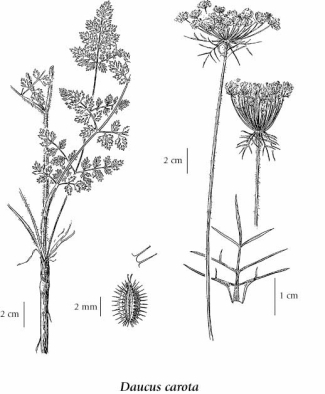wild carrot (Queen Anne's lace)
Apiaceae
Introduction to Vascular Plants
Photograph
© Diane Williamson (Photo ID #16815)
Introduction
Wild carrot (a.k.a. Queen Anne's lace) is an introduced member of the Carrot Family (Apiaceae) that is native to Eurasia. It is found in North America in disturbed sites in most US states and several Canadian provinces (USDA 2010). In British Columbia, it is common in the southwestern corner of the province (SE Vancouver Island, the Gulf Islands and adjacent mainland) and is also found in the south-central region (including Kelowna, Vernon, and adjacent areas).
Wild carrot is a relatively small biennial species (up to 1m tall) with a well-developed taproot. It is summer flowering (July through to September in BC). The inflorescence is white (sometimes yellowish) and is comprised of numerous compact umbels of flowers, 3-7 cm wide. A conspicuous central purple or pink flower is often present. Leaves are bipinnate and fern-like in appearance. The root of this species smells like carrot. |
Species Information
General:
Coarse biennial herb from a well-developed, whitish, bitter taproot, hairy throughout to nearly glabrous; stems single, 20-120 cm tall.
Leaves:
Basal and stem leaves pinnately dissected with small, narrow ultimate segments, fernlike, with short stalks, the blades 5-15 cm long.
Flowers:
Inflorescence of numerous, compound umbels with small compact heads; flowers white or yellowish (but the central flower of the umbel commonly purple or pink); involucral bracts with paper-like edges below; segments threadlike to awl-shaped.
Fruits:
Egg-shaped, 3-4 mm long, ribbed and armed with barbed prickles along alternate ribs; inflorescence narrower in fruit than in flower, and with outer, longer spokes arching inwards, producing a "bird's nest" effect.
Illustration

If more than one illustration is available for a species (e.g., separate illustrations were provided for two subspecies) then links to the separate images will be provided below. Note that individual subspecies or varietal illustrations are not always available.
Illustration Source: The Illustrated Flora of British Columbia
Ecology
The table below shows the species-specific information calculated from
original data (BEC database) provided by the BC Ministry of Forests and Range.
(Updated August, 2013)
| Site Information |
Value / Class |
||
|
Avg |
Min |
Max |
|
| Elevation
(metres) |
791 | 35 | 1791 |
| Slope
Gradient (%) |
15 | 3 | 41 |
|
Aspect (degrees) |
252 | 180 | 360 |
| Soil
Moisture Regime (SMR) [0 - very xeric; 4 - mesic; 8 - hydric] |
3 | 3 | 4 |
| Modal
Nutrient Regime
Class |
D | ||
| #
of field plots species was recorded in: |
9 | ||
| Modal
BEC Zone Class |
BG | ||
|
All BEC Zones (# of stations/zone) species was recorded in |
BG(2), CDF(1), ESSF(1), IDF(1) | ||
|
Source:
Klinkenberg 2013
|
|||
Habitat and Range
Roadsides, fields and waste places in the lowland zone; common in SW BC, known from SE Vancouver Island, the Gulf Islands and adjacent mainland, also known from Vernon; introduced from Eurasia.Status Information
Synonyms
Synonyms and Alternate Names:
Daucus carota subsp. carota
Daucus carota subsp. sativus (Hoffm.) Arcang.
Taxonomic Keys
1. Involucral bracts with paper-like edges below; leaf segments threadlike to awl-shaped; plants introduced, coarse biennials.................. D. carota
1. Involucral bracts without paper-like edges below; leaf segments linear or lanceolate, scarcely elongate; plants native, slender annuals..................... D. pusillus Source: Illustrated Flora of British Columbia |
Taxonomic Notes
Wild carrot is considered an emerging invasive species by the Greater Vancouver Invasive Plant Council (2009). An emerging invasive is defined by them as: currently found in isolated, sparse populations but are rapidly expanding their range within the region. Wild carrot is the wild ancestor of the cultivated carrot (Pojar and MacKinnon 1994).
|